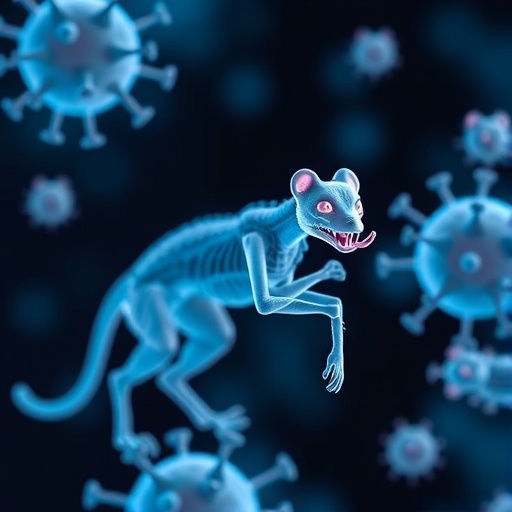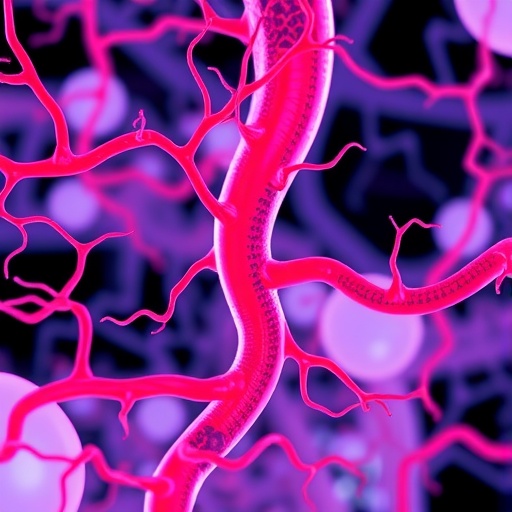In the rapidly evolving field of forensic science and wildlife conservation, the ability to accurately and efficiently identify species from biological samples has become paramount. Addressing this critical need, a groundbreaking study by Jiang, Song, Liu, and colleagues introduces two novel assays aimed at distinguishing among twelve animal species alongside human beings with unprecedented accuracy. This advancement holds vast implications for legal investigations, biodiversity studies, and the burgeoning field of forensic genetics.
The researchers dive into a complex challenge that has long confounded forensic experts: differentiating closely related species from minute or degraded biological materials. Traditional methods often rely on morphological traits or limited genetic markers that can be ambiguous, especially in mixed samples or when DNA quality is compromised. The study leverages cutting-edge molecular techniques to overcome these hurdles, pushing the frontier of species identification into new territory.
Central to the innovation are two distinct assays that harness species-specific genetic markers. The first assay utilizes multiplex polymerase chain reaction (PCR) combined with fluorescent-labeled primers, enabling simultaneous amplification of multiple target sequences unique to each species. This multiplexing approach significantly reduces test time and minimizes sample consumption, essential advantages in forensic scenarios where evidence is both precious and limited.
Complementing this, the second assay employs a CRISPR-based detection system, harnessing the precision of guide RNA molecules calibrated to species-specific DNA sequences. This assay amplifies sensitivity, allowing detection down to minute quantities of genetic material with a robust mechanism to distinguish closely related species without cross-reactivity. Notably, this CRISPR assay can be conducted outside of traditional laboratory settings, opening doors to field applications essential for rapid identification.
The research team validated both assays against a diverse panel of twelve common animals frequently encountered in forensic investigations — ranging from domestic species like dog and horse to wildlife such as deer and wild boar — alongside human DNA. Across extensive sample sets comprising fresh, degraded, and mixed DNA, both assays demonstrated high specificity and sensitivity, with accuracy rates exceeding 98%. Such performance benchmarks represent a significant improvement upon existing species identification techniques.
Moreover, the assays exhibited remarkable reproducibility and robustness, with cross-laboratory testing affirming their reliability. Importantly, the methods proved resilient to common inhibitors and contaminants typical in forensic samples, further underscoring their practicality in real-world scenarios where sample integrity cannot be guaranteed. These qualities render the assays invaluable tools for forensic casework, wildlife forensic investigations, and even customs or trade monitoring of protected species.
The implications of this research are multifaceted. In forensic contexts, rapid and reliable species identification can decisively inform legal outcomes, such as in cases of poaching, illegal wildlife trafficking, and human-animal conflicts. By providing unambiguous species confirmation, investigators can reconstruct events with greater certainty, while prosecution hinges on scientifically sound evidence. The assays’ ability to differentiate between human and animal DNA also bolsters criminal investigations that require discrimination between species, such as when interpreting mixed bloodstains or bite marks.
Beyond forensic applications, these assays are poised to accelerate conservation efforts. Wildlife monitoring frequently grapples with identifying species from traces like hair, feces, or environmental DNA. The assays afford conservation biologists rapid tools to survey biodiversity, assess population dynamics, and monitor illegal hunting activities with enhanced precision. When coupled with portable detection devices, these tools empower field researchers to make informed decisions in near real-time, a leap forward from traditional laboratory-bound analyses.
Technically, the multiplex PCR assay is engineered with primers carefully designed to target mitochondrial DNA regions known for interspecies variability yet conserved within species. This genetic focus balances specificity and amplification efficiency, while fluorescent labeling allows simultaneous signal detection in a single run. The design process meticulously avoided primer-dimer formation and cross-reactivity, ensuring clean and interpretable results.
The CRISPR detection system, on the other hand, integrates Cas12a effector proteins guided by synthetic RNAs customized to recognize single nucleotide polymorphisms unique to each species. Upon target recognition, activated Cas12a cleaves reporter molecules to produce a fluorescent signal, serving as a real-time indicator of species presence. The assay operates isothermally, circumventing requirements for thermal cycling and making it amenable to portable, point-of-care platforms.
Importantly, the study addresses potential limitations head-on, including challenges posed by degraded DNA and mixed samples. Performance assessments demonstrated the assays’ capacity to detect minority species in mixed specimens, boasting sensitivity to as low as 5% DNA contribution. This feature is particularly critical during forensic analysis of complex evidence items containing biological materials from multiple sources.
Furthermore, the researchers outline pathways for extending the assay panels to additional species, underscoring the modularity and scalability of their approach. By applying the same design principles and assay frameworks, expanding the repertoire to cover endangered or geographically diverse species becomes feasible, paving the way for a comprehensive global forensic and ecological identification toolkit.
Beyond technical validation, the study explores the regulatory and practical integration of these assays into forensic workflows. Considerations include standardization procedures, quality control benchmarks, and data interpretation guidelines to ensure consistent application across laboratories. The authors advocate for collaborative efforts with forensic accreditation bodies to mainstream these novel assays, promising to elevate standards in forensic species identification.
This research arrives at a crucial moment when wildlife crime and environmental forensics demand advanced, reliable molecular tools. Illegal trafficking and habitat destruction call for technologies capable of delivering swift, unequivocal identifications to enforce legal protections effectively. Concurrently, with forensic agencies facing increasing workloads and complex cases, the adoption of high-throughput, multiplexed assays promises operational efficiencies without compromising evidentiary integrity.
In conclusion, the pioneering assays presented by Jiang and his team mark a transformative advance in forensic genetics and wildlife monitoring. By ingeniously combining multiplex PCR and CRISPR-based detection, they bring unprecedented speed, accuracy, and versatility to the challenge of species identification. The potential ripple effects span legal medicine, conservation biology, and beyond, heralding a future where complex biological inquiries are answered swiftly and with scientific certainty.
The study exemplifies how interdisciplinary innovation—melding molecular biology, bioinformatics, and forensic science—can address entrenched challenges with elegant solutions. With continued development and widespread deployment, these assays could redefine standards for species identification in both forensic and ecological arenas, catalyzing efforts to protect biodiversity and uphold justice.
Subject of Research: Species identification of twelve animal species and human beings using innovative molecular assays.
Article Title: Addressing species identification of 12 animals and human beings with two novel assays.
Article References:
Jiang, L., Song, F., Liu, B. et al. Addressing species identification of 12 animals and human beings with two novel assays. Int J Legal Med (2025). https://doi.org/10.1007/s00414-025-03604-0
Image Credits: AI Generated
Tags: animal species identification methodsbiodiversity research applicationschallenges in species differentiationcutting-edge molecular techniquesdegraded biological samples analysisforensic genetics innovationsforensic science advancementslegal investigations in forensicsmultiplex PCR technologynovel genetic assaysspecies-specific genetic markerswildlife conservation techniques





